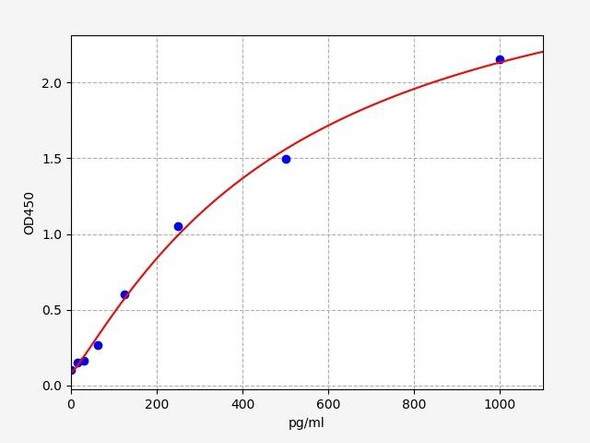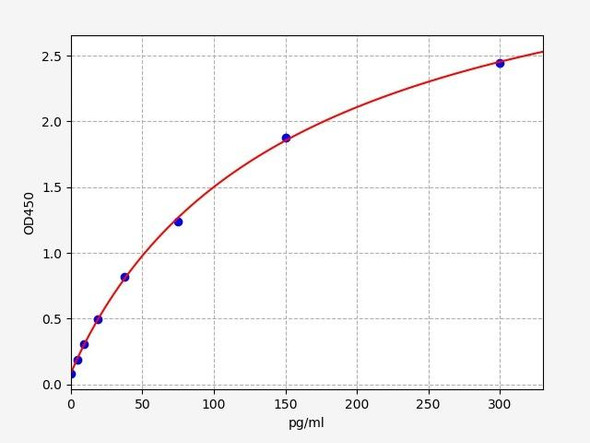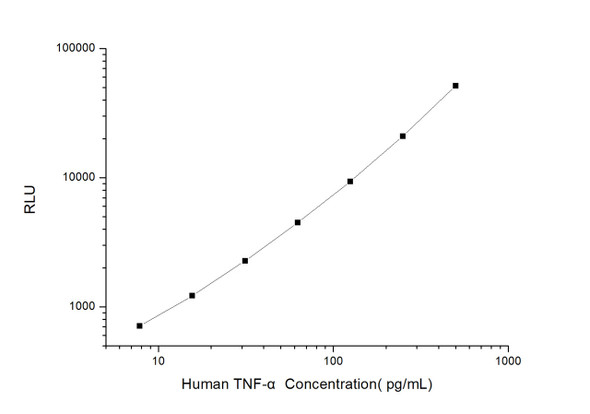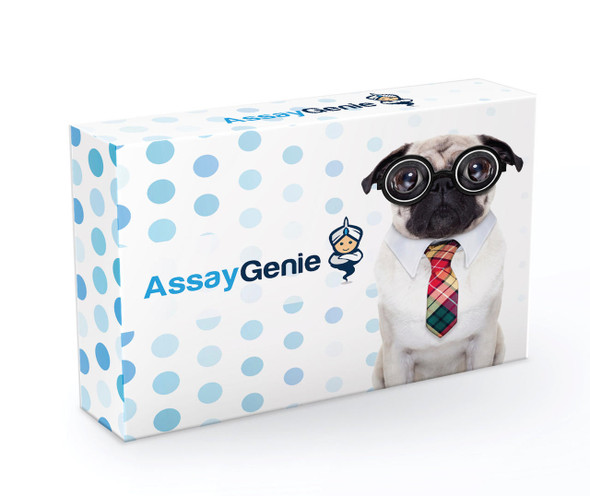Human Cell Biology ELISA Kits 5
Human TNF- alpha (Tumor Necrosis Factor Alpha) ELISA Kit (HUES01395)
- SKU:
- HUES01395
- Product Type:
- ELISA Kit
- Size:
- 96 Assays
- Uniprot:
- P01375
- Sensitivity:
- 4.69pg/mL
- Range:
- 7.81-500pg/mL
- ELISA Type:
- Sandwich
- Synonyms:
- DIF, TNF-alpha, TNFA, TNFSF2
- Reactivity:
- Human
- Sample Type:
- Serum, plasma and other biological fluids
- Research Area:
- Cell Biology
Description
| Assay type: | Sandwich |
| Format: | 96T |
| Assay time: | 4.5h |
| Reactivity: | Human |
| Detection Method: | Colormetric |
| Detection Range: | 7.81-500 pg/mL |
| Sensitivity: | 4.69 pg/mL |
| Sample Volume Required Per Well: | 100µL |
| Sample Type: | Serum, plasma and other biological fluids |
| Specificity: | This kit recognizes Human TNF- alpha in samples. No significant cross-reactivity or interference between Human TNF- alpha and analogues was observed. |
This ELISA kit uses Sandwich-ELISA as the method. The micro ELISA plate provided in this kit has been pre-coated with an antibody specific to Human TNF- alpha. Standards or samples are added to the appropriate micro ELISA plate wells and combined with the specific antibody. Then a biotinylated detection antibody specific for Human TNF- alpha and Avidin-Horseradish Peroxidase (HRP) conjugate are added to each micro plate well successively and incubated. Free components are washed away. The substrate solution is added to each well. Only those wells that contain Human TNF- alpha, biotinylated detection antibody and Avidin-HRP conjugate will appear blue in color. The enzyme-substrate reaction is terminated by adding Stop Solution and the color turns yellow. The optical density (OD) is measured spectrophotometrically at a wavelength of 450 nm ± 2 nm. The OD value is proportional to the concentration of Human TNF- alpha. The concentration of Human TNF- alpha in samples can be calculated by comparing the OD of the samples to the standard curve.
| UniProt Protein Function: | TNF-a: Cytokine that binds to TNFRSF1A/TNFR1 and TNFRSF1B/TNFBR. It is mainly secreted by macrophages and can induce cell death of certain tumor cell lines. It is potent pyrogen causing fever by direct action or by stimulation of interleukin-1 secretion and is implicated in the induction of cachexia, Under certain conditions it can stimulate cell proliferation and induce cell differentiation. Homotrimer. Interacts with SPPL2B. Belongs to the tumor necrosis factor family. |
| UniProt Protein Details: | Protein type:Membrane protein, integral; Motility/polarity/chemotaxis; Apoptosis; Cytokine Chromosomal Location of Human Ortholog: 6p21. 3 Cellular Component: extracellular space; recycling endosome; cell surface; integral to plasma membrane; extracellular region; plasma membrane; external side of plasma membrane; phagocytic cup; lipid raft Molecular Function:identical protein binding; protein binding; protease binding; cytokine activity; tumor necrosis factor receptor binding Biological Process: positive regulation of JNK activity; extracellular matrix organization and biogenesis; positive regulation of nitric oxide biosynthetic process; positive regulation of NFAT protein import into nucleus; activation of MAPK activity; positive regulation of osteoclast differentiation; positive regulation of apoptosis; positive regulation of transcription, DNA-dependent; response to glucocorticoid stimulus; positive regulation of caspase activity; positive regulation of NF-kappaB import into nucleus; osteoclast differentiation; positive regulation of translational initiation by iron; positive regulation of membrane protein ectodomain proteolysis; activation of NF-kappaB transcription factor; positive regulation of MAP kinase activity; tumor necrosis factor-mediated signaling pathway; positive regulation of phagocytosis; negative regulation of interleukin-6 production; JNK cascade; negative regulation of osteoblast differentiation; positive regulation of action potential; regulation of immunoglobulin secretion; embryonic gut development; negative regulation of protein complex disassembly; positive regulation of cytokine production; response to drug; positive regulation of I-kappaB kinase/NF-kappaB cascade; positive regulation of heterotypic cell-cell adhesion; positive regulation of mitosis; response to virus; positive regulation of interleukin-8 biosynthetic process; glucose metabolic process; positive regulation of interleukin-6 production; negative regulation of fat cell differentiation; positive regulation of chemokine production; negative regulation of cytokine secretion during immune response; positive regulation of protein transport; detection of mechanical stimulus involved in sensory perception of pain; cell activation; defense response to Gram-positive bacterium; induction of apoptosis via death domain receptors; DNA damage response, signal transduction resulting in induction of apoptosis; positive regulation of transcription from RNA polymerase II promoter; positive regulation of transcription factor activity; negative regulation of L-glutamate transport; response to activity; negative regulation of transcription, DNA-dependent; skeletal muscle contraction; sequestering of triacylglycerol; positive regulation of smooth muscle cell proliferation; negative regulation of transcription from RNA polymerase II promoter; positive regulation of interleukin-18 production; chronic inflammatory response to antigenic stimulus; response to salt stress; positive regulation of synaptic transmission; positive regulation of hair follicle development; negative regulation of cell proliferation; response to radiation; negative regulation of lipid catabolic process; positive regulation of neuron apoptosis; protein kinase B signaling cascade; lipopolysaccharide-mediated signaling pathway; positive regulation of chronic inflammatory response to antigenic stimulus; inflammatory response; regulation of I-kappaB kinase/NF-kappaB cascade; caspase activation; positive regulation of humoral immune response mediated by circulating immunoglobulin; positive regulation of protein complex disassembly; transformed cell apoptosis; MAPKKK cascade; calcium-mediated signaling; positive regulation of peptidyl-serine phosphorylation; humoral immune response; positive regulation of protein kinase B signaling cascade; positive regulation of interferon-gamma production; negative regulation of glucose import; positive regulation of programmed cell death; positive regulation of chemokine biosynthetic process; positive regulation of protein complex assembly; negative regulation of viral genome replication; protein import into nucleus, translocation; positive regulation of protein kinase activity; response to hypoxia; positive regulation of fever; activation of MAPKKK activity; receptor biosynthetic process; positive regulation of protein amino acid phosphorylation; leukocyte tethering or rolling; negative regulation of myoblast differentiation; regulation of insulin secretion; positive regulation of cytokine secretion Disease: Asthma, Susceptibility To; Migraine With Or Without Aura, Susceptibility To, 1; Malaria, Susceptibility To |
| NCBI Summary: | This gene encodes a multifunctional proinflammatory cytokine that belongs to the tumor necrosis factor (TNF) superfamily. This cytokine is mainly secreted by macrophages. It can bind to, and thus functions through its receptors TNFRSF1A/TNFR1 and TNFRSF1B/TNFBR. This cytokine is involved in the regulation of a wide spectrum of biological processes including cell proliferation, differentiation, apoptosis, lipid metabolism, and coagulation. This cytokine has been implicated in a variety of diseases, including autoimmune diseases, insulin resistance, and cancer. Knockout studies in mice also suggested the neuroprotective function of this cytokine. [provided by RefSeq, Jul 2008] |
| UniProt Code: | P01375 |
| NCBI GenInfo Identifier: | 135934 |
| NCBI Gene ID: | 7124 |
| NCBI Accession: | P01375. 1 |
| UniProt Secondary Accession: | P01375,O43647, Q9P1Q2, Q9UIV3, |
| UniProt Related Accession: | P01375 |
| Molecular Weight: | 25,644 Da |
| NCBI Full Name: | Tumor necrosis factor |
| NCBI Synonym Full Names: | tumor necrosis factor |
| NCBI Official Symbol: | TNF |
| NCBI Official Synonym Symbols: | DIF; TNFA; TNFSF2; TNF-alpha |
| NCBI Protein Information: | tumor necrosis factor; TNF-a; cachectin; APC1 protein; TNF, monocyte-derived; TNF, macrophage-derived; tumor necrosis factor-alpha; tumor necrosis factor ligand superfamily member 2 |
| UniProt Protein Name: | Tumor necrosis factor |
| UniProt Synonym Protein Names: | Cachectin; TNF-alpha; Tumor necrosis factor ligand superfamily member 2; TNF-a |
| Protein Family: | Tumor necrosis factor |
| UniProt Gene Name: | TNF |
| UniProt Entry Name: | TNFA_HUMAN |
As the OD values of the standard curve may vary according to the conditions of the actual assay performance (e. g. operator, pipetting technique, washing technique or temperature effects), the operator should establish a standard curve for each test. Typical standard curve and data is provided below for reference only.
| Concentration (pg/mL) | O.D | Average | Corrected |
| 500 | 2.427 2.445 | 2.436 | 2.376 |
| 250 | 1.562 1.584 | 1.573 | 1.513 |
| 125 | 0.993 0.979 | 0.986 | 0.926 |
| 62.5 | 0.477 0.515 | 0.496 | 0.436 |
| 31.25 | 0.245 0.237 | 0.241 | 0.181 |
| 15.63 | 0.166 0.16 | 0.163 | 0.103 |
| 7.81 | 0.105 0.121 | 0.113 | 0.053 |
| 0 | 0.059 0.061 | 0.06 | -- |
Precision
Intra-assay Precision (Precision within an assay): 3 samples with low, mid range and high level Human TNF- alpha were tested 20 times on one plate, respectively.
Inter-assay Precision (Precision between assays): 3 samples with low, mid range and high level Human TNF- alpha were tested on 3 different plates, 20 replicates in each plate.
| Intra-assay Precision | Inter-assay Precision | |||||
| Sample | 1 | 2 | 3 | 1 | 2 | 3 |
| n | 20 | 20 | 20 | 20 | 20 | 20 |
| Mean (pg/mL) | 24.10 | 79.50 | 183.00 | 22.70 | 86.50 | 177.40 |
| Standard deviation | 1.50 | 3.80 | 9.70 | 1.20 | 4.00 | 7.60 |
| C V (%) | 6.22 | 4.78 | 5.30 | 5.29 | 4.62 | 4.28 |
Recovery
The recovery of Human TNF- alpha spiked at three different levels in samples throughout the range of the assay was evaluated in various matrices.
| Sample Type | Range (%) | Average Recovery (%) |
| Serum (n=5) | 86-100 | 92 |
| EDTA plasma (n=5) | 94-106 | 99 |
| Cell culture media (n=5) | 93-107 | 99 |
Linearity
Samples were spiked with high concentrations of Human TNF- alpha and diluted with Reference Standard & Sample Diluent to produce samples with values within the range of the assay.
| Serum (n=5) | EDTA plasma (n=5) | Cell culture media (n=5) | ||
| 1:2 | Range (%) | 92-105 | 84-97 | 88-99 |
| Average (%) | 99 | 91 | 93 | |
| 1:4 | Range (%) | 99-116 | 87-99 | 91-104 |
| Average (%) | 107 | 93 | 98 | |
| 1:8 | Range (%) | 97-113 | 81-93 | 92-109 |
| Average (%) | 104 | 88 | 99 | |
| 1:16 | Range (%) | 96-112 | 85-98 | 95-107 |
| Average (%) | 103 | 90 | 100 |
An unopened kit can be stored at 4°C for 1 month. If the kit is not used within 1 month, store the items separately according to the following conditions once the kit is received.
| Item | Specifications | Storage |
| Micro ELISA Plate(Dismountable) | 8 wells ×12 strips | -20°C, 6 months |
| Reference Standard | 2 vials | |
| Concentrated Biotinylated Detection Ab (100×) | 1 vial, 120 µL | |
| Concentrated HRP Conjugate (100×) | 1 vial, 120 µL | -20°C(shading light), 6 months |
| Reference Standard & Sample Diluent | 1 vial, 20 mL | 4°C, 6 months |
| Biotinylated Detection Ab Diluent | 1 vial, 14 mL | |
| HRP Conjugate Diluent | 1 vial, 14 mL | |
| Concentrated Wash Buffer (25×) | 1 vial, 30 mL | |
| Substrate Reagent | 1 vial, 10 mL | 4°C(shading light) |
| Stop Solution | 1 vial, 10 mL | 4°C |
| Plate Sealer | 5 pieces | |
| Product Description | 1 copy | |
| Certificate of Analysis | 1 copy |
- Set standard, test sample and control (zero) wells on the pre-coated plate and record theirpositions. It is recommended to measure each standard and sample in duplicate. Note: addall solutions to the bottom of the plate wells while avoiding contact with the well walls. Ensuresolutions do not foam when adding to the wells.
- Aliquot 100 µL of standard solutions into the standard wells.
- Add 100 µL of Sample / Standard dilution buffer into the control (zero) well.
- Add 100 µL of properly diluted sample (serum, plasma, tissue homogenates and otherbiological fluids) into test sample wells.
- Cover the plate with the sealer provided in the kit and incubate for 90 min at 37 °C.
- Aspirate the liquid from each well, do not wash. Immediately add 100 µL of BiotinylatedDetection Ab working solution to each well. Cover the plate with a plate seal and gently mix. Incubate for 1 hour at 37 °C.
- Aspirate or decant the solution from the plate and add 350 µL of wash buffer to each welland incubate for 1-2 minutes at room temperature. Aspirate the solution from each well andclap the plate on absorbent filter paper to dry. Repeat this process 3 times. Note: a microplatewasher can be used in this step and other wash steps.
- Add 100 µL of HRP Conjugate working solution to each well. Cover with a plate seal andincubate for 30 min at 37 °C.
- Aspirate or decant the solution from each well. Repeat the wash process for five times asconducted in step 7.
- Add 90 µL of Substrate Reagent to each well. Cover with a new plate seal and incubate forapproximately 15 min at 37 °C. Protect the plate from light. Note: the reaction time can beshortened or extended according to the actual color change, but not by more than 30min.
- Add 50 µL of Stop Solution to each well. Note: Adding the stop solution should be done inthe same order as the substrate solution.
- Determine the optical density (OD value) of each well immediately with a microplate readerset at 450 nm.






